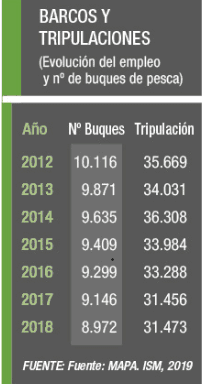The Spanish fishing sector keeps its leadership in Europe in terms of catches in 2018, although, on the other hand, it is alarmed by 19% fall of domestic fish consumption in the last ten years.
According to the report presented by the sectorial organization Cepesca, in 2018, the Spanish fleet caught 922, 564 tons of fish and shellfish, 1.9% less than the previous year. In 2017, the value of the Spanish catches was almost €2, 2 billion. With these figures, Spain validates one more year its leadership in the EU, with a quota of 20%.
Fish trade
In 2018, Spain imported 1, 8 million tons (-0.6%) of fish products worth €7, 32 billion (+2.49%). Exports amounted 1, 2 million tons (+1.5%), worth €4, 3 billion (+4.3%). Despite of the fact that the trade balance is still negative for Spain, there has been an upward trend in exports over the last decade.
Fish trade evolution between 2008 and 2018
Seventy six percent of Spanish fish exports go to the EU, while 66% of imports come from third countries.
Where Spain sold and bought fish products
The Spanish fleet ranks third in the EU
In 2018, the fleet was made up of 8,972 vessels and the adjustment plan has been maintained since Spain’s entry into the EU. In this regard, 174 units were scrapped in 2018. Of the total vessel number, the national fishing ground account for most of them (96%), although the fleet operating in EU and international waters accounts for more than 60% of Spain’s total catches.
Spain maintain its third position in number of boats in Europe, after Greece (14,000) and Italy (12,000).

Evolution of fishing vessel number and sector employment
This sector generated 31,473 direct jobs in 2018, about the same as in 2017, representing 20% of the European total fisheries employment.
Domestic fish consumption: one of the sector’s main concerns
According to Cepesca’s report and data from other sources, Spaniards are stopping to eat fish products. The consumption trend of the last ten years is a constant decline that has alarmed the sector.
If in 2017, the consumption of fishery products was 1,300 tons, in 2017, it fell to one thousand tons, representing a decrease of 19% in these last ten years. Per person per year, consumption has fallen from 29.9 kilos in 2007 to 23.7 kilos in 2017 and 23.4 kilos in 2018.
Fish consumption on Spanish households
The causes of this worrying decrease, according to Javier Garat, Cepesca’s Secretary General, would be changes in habits, arising from the lack of time to do the shopping and prepare the food, along with price, especially in times of crisis.
In order to find a solution to this problem, Cepesca, together with other value chain operators, has been demanding for some time the VAT reduction on fishery products from the current 10% to 4%, which in Spain applies for other basic foods such as bread or milk.
The most pressing problems of the sector
Apart from the fish consumption, the shortage of crew is unanimously the most pressing challenge. To alleviate the situation, Cepesca has launched a strategic plan to attract Spanish talent and facilitate foreigners hiring.
Another sector challenge is its fleet age. More than 2,700 boats (out of almost 9,000) are over 40 year old. The sector thinks that it is necessary to undertake a renewal and modernization plan, in which Cepesca considers the future EMFF should also be involved.
Two other major sector concerns are the landing obligation and the Brexit.
Environmental initiatives
One of the most active strategic areas of the Spanish sector during 2018 has been the environment. Last year, Cepesca launched the Fish-Recycle project to support the sector towards a circular economy, as well as a sectoral strategy for marine waste reduction.
In addition to this, Cepesca’s report highlights the sector collaboration with the scientific world in the conviction that an efficient fisheries management must be based on the best scientific data. Specifically, the organization mentions its PesConect project, which has the Spanish Institute for Oceanography (IEO) as a partner.
Another example of the cooperation between the sector and the research institutions is the project “New technologies in Natura 2000: the fishing sector contribution to the conservation of protected areas of the Gulf of Cádiz”.
Sources: Cepesca and ABC